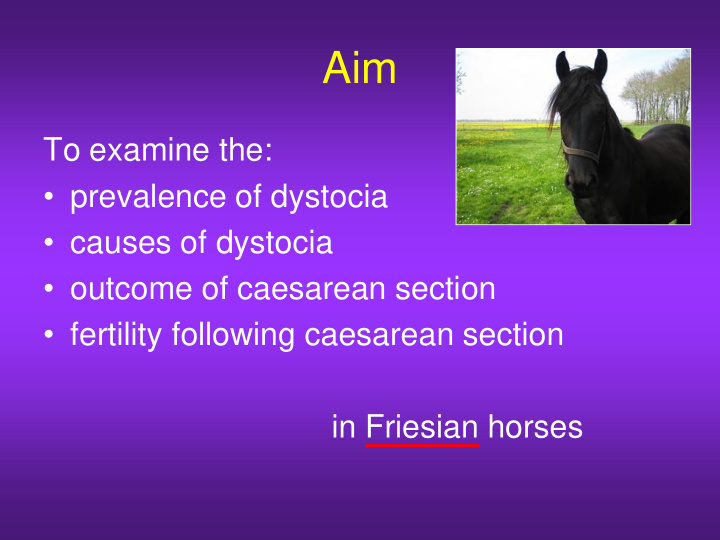



Aim To examine the: • prevalence of dystocia • causes of dystocia • outcome of caesarean section • fertility following caesarean section in Friesian horses
Materials & Methods Materials: • retrospective study • hospital records of mares referred for dystocia during 2001 – 2006 • follow-up survey by telephone
Materials & Methods Treatment options: • assisted vaginal delivery (AVD) • fetotomy (FT) • Caesarean Section (CS) Decision based on – is reposition possible? – foal - live or dead? – is fetotomy possible in < 2-3 cuts?
Materials & Methods
Materials & Methods Method: SC • isoxsuprine/ampicilline/flunixine • GA • laparatomy via ventral midline • uterine closure: – (I) continuous haemostatic suture – (II) modified Cushing’s • wound closure: – 4 layers – muscle/tendon layer: continuous 6-8M vicryl • intra-operative oxytocin infusion (50 I.U.)
Materials & Methods Methods: postoperative management • placenta removal – oxytocin infusion – gentle traction • oxytetracyclin tablets i.u. • oxytocin regime (20 I.U. q2h, 3 days) • penicillin/ gentamycin/flunixin
Results: prevalence Breed hospital population dystocia cases n = 409 n = 66 Friesian 35% 57 (86%) Dutch Warmblood 33% 5 (7%) Standardbred 20% 1 (2%) Shetland pony 1% 3 (5%) miscellaneous 11%
Prevalence Breed AVD FT CS n = 5 n = 11 n = 50 Friesian 3 9 45 Dutch 2 1 2 Warmblood Standardbred 0 0 1 Shetland 0 1 2 pony
Cause of dystocia Friesian Friesian Literature dystocia dystocia reference 1 1 2 2 3 3 4 7 cases cases % anterior 12 21 56 76 55 68 posterior 5 9 10 14 16 16 transverse 11 19 12 10 9 16 malformation 22 39 10 (7) (10) oversized 0 0 5 (2) 6 uterine torsion 0 0 (3) 5 hydrocephalus 1 2 (5) unknown 6 11 total 57 100% 88% 100% 91% 100% n = 57 n = 166 n = 150 n = 96 n = 601
Caesarean Section 45 Friesian CS • mare survival to hospital discharge 41/45 (91%) • lit. ref. 81-89% 1,3,5,8 • complications: – wound dehiscence 5 – laminitis 3 – endometritis 3 – peritonitis 1 – rectal prolapse 1 – colic 1 – uterine haemorrhage 1 – broad ligament haemorrhage 1 – vaginal haemorrhage 1
Caesarean Section 45 CS on Friesian mares • live foals - 19/45 (42%) • 5 euthanized - severe malformation • survival to hospital discharge - 14/45 (31%) • lit. ref. 31% 1 , 11% 4 , 4% 6 , 30% 8
Dystocia duration Friesian CS lit. ref. lit. ref. 1 1 2 5 n = 33 mean ± sd mean ± sd mean live foal 165’ ± 73’ 71.7’ ± 34.3’ 71’ at birth dead 490’ ± 504’ 85.3’ ± 37.4’ 282’ foal
Fertility after CS 45 Friesians post CS • 23/45 re-bred • mean duration CS to next pregnancy : 9.2 ± 8.4 months (n = 21) • all re-bred mares produced a live foal (100%) • lit. ref. 67% 1 , 50% 4
Discussion • high prevalence of dystocia in Friesian mares • due to a high % of transverse presentations and malformations (wry nose, torticollis and limb malformation)
Discussion Transverse position • normal development of the foetus in one uterine horn during the 5-7 th month development in the corpus uteri • occasionally development in the second horn instead of the corpus the cranial half of the foetus is hindered in its development malformations • foetal development in both horns instead of corpus elongation of the corpus foetus is farther away from the pelvic inlet difficult manual reposition
Discussion Causes of malformation Uterine environment 9 Genetic factors • Friesian’s are • increased % transverse highly inbred presentation in cold-bloods • in ruminants - • no known genetic factor in arthrogryposis is an Belgian draught horse autosomal population recessive condition • rapid correction of malformed extremities post-partum
Discussion
Discussion CS in Friesian mares • mare survival is good • preservation of reproductive soundness is also good • despite dystocia of relatively long duration, chance of a live foal is substantial – delayed stage II labour in (partial) transverse positions – slower placental detachment in Friesians?
References 1. Byron C.R. et al. 2002; EVJ 35 p 82-85 2. Frazer G.S. 1997; EVJ 29 p 111-116 3. Freeman D.E. et al.1999; EVJ 31 p 203-207 4. Juzwiak J.S. 1990; Vet. Surgery 19 p 50-52 5. Lynch Norton J. et al. 2007; EVJ 39 p 37-41 O’Donnell M.J. and Bathe A.P. 2005; Proc. Of the 6. 44th BEVA Congress p 245 7. Vandeplassche M. 1987; J. Reprod. Fertil. Suppl. 35 p 547-552 8. Vandeplassche M. 1980; EVJ 12 p 45-49 9. Vandeplassche M. et al. 1984; EVJ 16 p 419-424
Afterbirth/placenta
Afterbirth • Increased prevalence of retentio secundinarum • In 9/10 cases removal is possible by means of oxytocin infusion and gentle traction ( no “pealing”) • Cause? Effect of inbreeding on the incidence of retained placenta in Friesian horses. M Sevinga, T. Vrijenhoek, J W Hesselinks, H W Barkema, A.F. Groen Journal of Animal Science 05/2004; 82(4):982-6. Serum calcium and magnesium concentrations and the use of a calcium magnesium-borogluconate solution in the treatment of Friesian mares with retained placenta. M Sevinga, H W Barkema, J W Hesselink Theriogenology 01/2002; 57(2):941-7
Thank you for your attention!
Recommend
More recommend